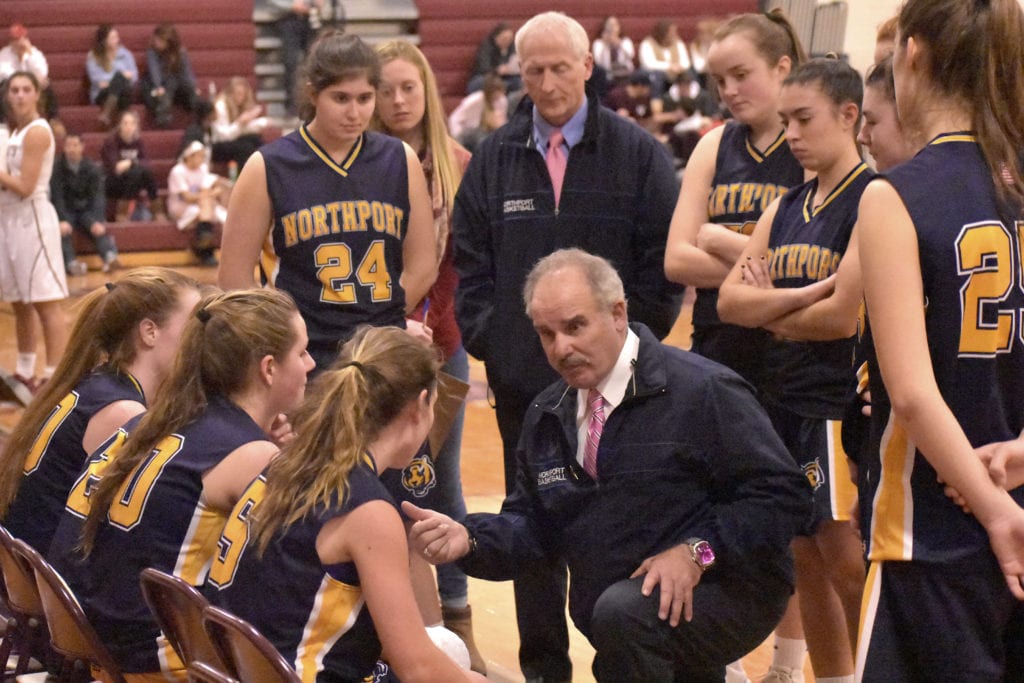By Jim Ferchland
The intensity was up and the noise level high as Middle Country and East Islip found themselves in familiar territory — duking it out for the county title for seven hours Feb. 3. Middle Country won by 42 pins after erasing an 43-pin deficit heading into game six to finally overcome East Islip after coming in second to the Redmen the last two years.
With emotional hugs and tears, Middle Country won its final game 1,147 to 1,062 after being up in games one through three. Amanda Scarfogliero finished with a 1,317 series, and saved her best for last, a 256 in Game 6, the team’s second highest score. No one on Middle Country bowled lower than a 202 in the final game. Scarfogliero was in tears as the final scores were being calculated.

“My heart dropped honestly,” Scarfogliero said. “I made a promise to this team and my parents that I’d get Middle Country up to Syracuse. That’s exactly what we did. I needed to get that last game-high, and I did it.”
Middle Country rallied back to win 6,454 to 6,412 in a thriller at Bowlero in Sayville, winning four of the six games.
Middle Country’s 69-year-old head coach Mandy Dominguez announced he will be retiring after coaching for 28 years and in Middle Country for 18.
“I’m so proud of these girls,” Dominguez said. “The girls did not give up. They all had 200s in the final game. They’re resilient, and a tough group of girls.”
East Islip came out on fire in Game 4 and Game 5, out-bowling Middle Country 1,131 to 1,020 in the latter to turn a 248-pin deficit into the 43-pin lead.
“I knew we could come back,” Dominguez said. “We were just hoping that East Islip wouldn’t get hot. The [Middle Country] girls came through and that’s the main thing.”
Freshman Hannah Skalacki came in with the highest average in the county for Middle Country at 223. She said there was a lot of pressure taking down East Islip. She rolled a 255 in Game 1 of a 1,330 series.
“I love competition,” Skalacki said. “When everything was going on, I felt the tension going everywhere.”

Senior Julie Acosta was the last bowler in starting rotation for Middle Country. She finished the last game with a 225 and had the team’s high game with a 279. Middle Country had mathematically already won before she bowled her final frame.
“I was so nervous,” Acosta said finishing up her game. “Knowing that we won, I just wanted it to be over with and be able to celebrate with my team.”
The last time Acosta went to states, she was in seventh grade, which was her first season with Middle Country.
In Dominguez’s final season coaching, he said going to the states is icing on the cake. The team will compete at The Oncenter March 10 at 9 a.m.
“I’m so happy, especially very happy for the girls,” Dominguez said. “East Islip has beat us every year for the past three or four years. This year, the seniors came through and they worked hard. They’re a great bunch of girls and a great bunch of talented bowlers.”
In other county bowling news:
Middle Country’s boys bowling placed fourth with 6,294 points.
East Islip claimed first by a landslide with 6,829 points to earn back-to-back county titles. In second was West Babylon with 6,353 and Sachem in third with 6,346.

Middle Country junior Noah Axinn bowled a 300 in his second game. He’s never bowled a sanctioned 300 before.
Senior Thomas Lettich finished sixth in the county in with a 223 average for Middle County. He has the fourth highest series in the county at 783. He will go to Syracuse to play in the All-Star game.
Comsewogue girls bowling team placed fifth in the county championship with 5,612 points. The Warriors won three of their six games.
“It’s kinda where I thought we would be,” Comsewogue head coach Bo Frimmer said. “I was hoping that we would somehow come in third, because it’s always tough to beat East Islip and Middle Country.”
Junior Hannah Manetta has the seventh highest average in the county at 216. She bowled an average of 221 in the tournament. Last year, Warriors finished in sixth.
“This year we bowled against a lot of the harder teams, which is when you bowl against harder competitors, it leads you to bowl better,” Manetta said. “It was pretty tough this year.”
This post was updated Feb. 5 to correct the deficit Middle Country overcame for the win.




 The operating budget generally receives most of the attention because it has the largest impact on our day-to-day lives and the services citizens receive. The operating budget process begins in the spring when the county executive tells the county departments and agencies what he expects the county financial situation will be in the next fiscal year and requests each department/agency head to submit a budget request for the coming fiscal year based on those expectations.
The operating budget generally receives most of the attention because it has the largest impact on our day-to-day lives and the services citizens receive. The operating budget process begins in the spring when the county executive tells the county departments and agencies what he expects the county financial situation will be in the next fiscal year and requests each department/agency head to submit a budget request for the coming fiscal year based on those expectations. 







 So Groundhog Day has become part of American culture. The official groundhog that gets yanked out of its burrow is Punxsutawney Phil, named for the town where the German immigrants settled. Thousands of people and the national media cover poor Phil’s treatment. And let us not forget there is the film, “Goundhog Day,” which is enjoyed by many people year after year after year.
So Groundhog Day has become part of American culture. The official groundhog that gets yanked out of its burrow is Punxsutawney Phil, named for the town where the German immigrants settled. Thousands of people and the national media cover poor Phil’s treatment. And let us not forget there is the film, “Goundhog Day,” which is enjoyed by many people year after year after year.











